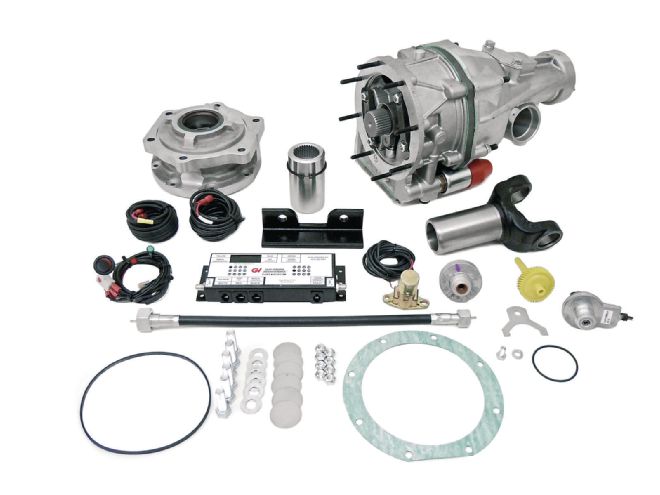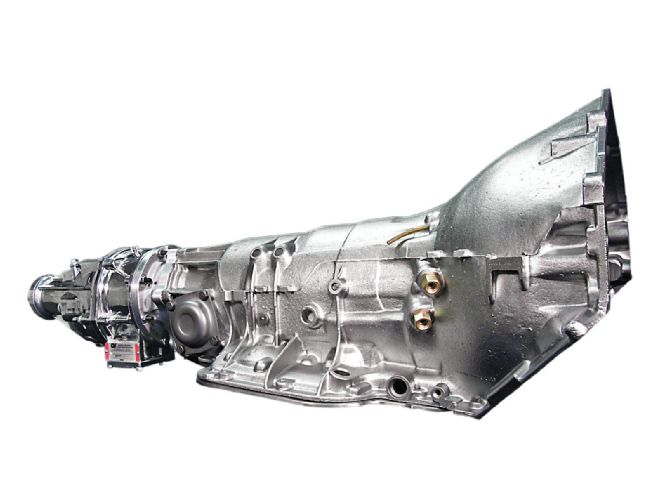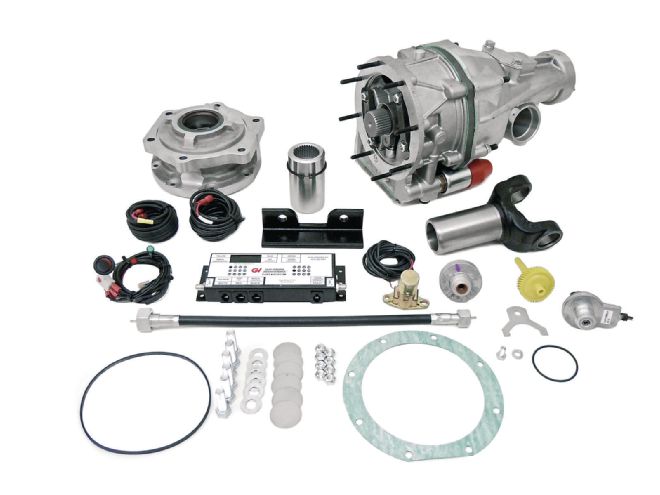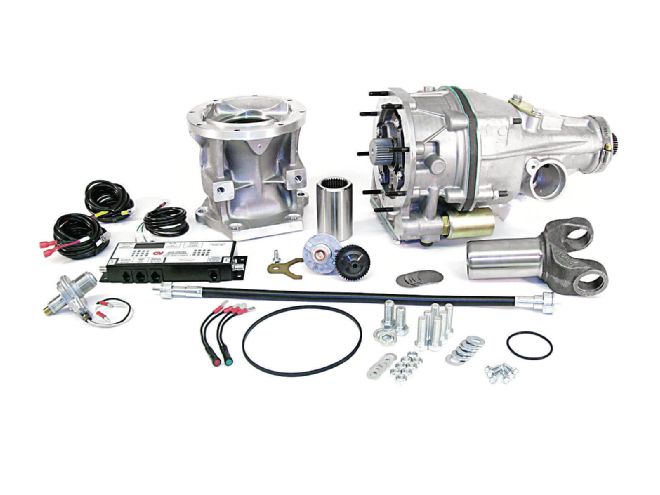
Ask Marlan A Tech Question: PitStop@HotRod.com
Q. I recently purchased my first classic car. It’s a ’65 Impala hardtop. The car is set up for the strip with the following parts:
 Gear Vendors Overdrive units are available to bolt up to most popular automatic and manual transmissions. The variant shown here is an ultrashort 2.5-inch extension-housing version for restricted space installations like race cars or street rods. Gear Vendors units have a two-year warranty, even when used in racing.
Gear Vendors Overdrive units are available to bolt up to most popular automatic and manual transmissions. The variant shown here is an ultrashort 2.5-inch extension-housing version for restricted space installations like race cars or street rods. Gear Vendors units have a two-year warranty, even when used in racing.
A. Matt, from the sound of it, you have a well-balanced combination for the car’s original intent. The only part that seemingly doesn’t match up with the rest of the parts is your apparent use of an Edelbrock Performer 2-O intake (PN 7161). I assume that’s a typo on your end because that manifold is only made for oval-port heads, and you say you have LS6 heads, which have rectangular ports. The Performer 2-O physically bolts on to rectangular-port heads, but there’s a significant port mismatch. It’s a fine street intake when used with the right heads from off-idle to 5,500 rpm, but the powerband on your 305H cam—one of Comp’s largest flat-tappet hydraulic grinds—is 3,000 to 6,800 rpm. I’m sure you really meant to list a Performer RPM 2-R (PN 7163) or RPM Air-Gap 2-R (PN 7562). Both intakes have at least a 1,500- to 6,500-rpm powerband, but we’ve seen them run higher and feel that series is the best all-around intake for a street big-block running a healthy cam.
In fact, your entire combination is basically built around the cam. Comp recommends at least 10.5:1 compression, a four-speed trans or 3,500-plus-rpm-stall-speed converter with an automatic, and 4.10:1 or numerically steeper gears. You’re basically right that if you change one thing it could indeed unbalance the combination. There are no easy answers here.
I’d start off by first trying your quieter muffler suggestion, and then maybe add some floorpan sound insulation. Search for “sound deadener” at Summit Racing, and you’ll get a whole range of options. If that’s not sufficient, then it’s time to bite the bullet and consider some drivetrain changes.
The traditional approach is milder rearend gears, but that in turn may require changing other stuff to bring the total combination back into harmony. How picky are you as far as your driveability envelope goes? Are we talking cruising at sustained highway speeds or in-town cruising? How many miles will you actually put on the car? You need to decide what is an acceptable engine rpm for the speeds at which you want to cruise. You can juggle cruise rpm, cruise-speed in mph, tire size, trans ratios, and rearend gear ratios using the following equation to come up with a possible rearend gear-ratio solution (algebraically transposing it as necessary to solve for any missing element).

Cruise rpm should not be so low that the car feels lazy with the big 305H cam. If your present cruise speed is about 3,200–3,500 rpm, you can take about 500 rpm off that amount and slide by with no major changes to other drivetrain parts besides rearend gearing.
Let’s say you can live with a 3,000-rpm cruise speed at 65 mph with the TH400’s 1.00:1 Third gear, and you have 26-inch tires. What available rear axle ratio will get you close?

The result yields a 3.57:1 rear-gear ratio. The closest real-world ratio available for a 12-bolt Chevy is 3.55:1 (such as Richmond PN 49-0095-1; $224.95 at Summit Racing). With the same combination, 3.42:1 gears (Richmond PN 49-0113-1; $203.95 at Summit) net you around a 2,873-rpm cruise speed. Traditionally, the 12-bolt Chevy car rearend differential case break is between 3.73:1 and 4.10:1. Anything 4.10:1 and numerically higher originally required a four-series differential case; 2.76:1 to 3.73:1 used a three-series case. If the new gears fell outside the range of your existing case, then a case swap was also needed.
 These are the components in Gear Vendors’ ultrashort kit for the 2.5-inch extension-housing TH400 (PN 3DFS403A). It uses the 4x4-style output shaft with a 1.325-inch stick-out and includes a transmission mount bracket because the mount is forward of the standard TH400 location. These units have very low parasitic losses (less than 1 hp/400 hp engine output).
These are the components in Gear Vendors’ ultrashort kit for the 2.5-inch extension-housing TH400 (PN 3DFS403A). It uses the 4x4-style output shaft with a 1.325-inch stick-out and includes a transmission mount bracket because the mount is forward of the standard TH400 location. These units have very low parasitic losses (less than 1 hp/400 hp engine output).
However, today there are special aftermarket 3.73:1 and 4.10:1 Chevy car 12-bolt gears for the three-series case available from vendors like Richmond (3.73:1 gears for four-series case, PN 49-0096-1; $224.95 at Summit). But this also means there’s a chance you could have a three-series differential case with the special 4.10:1 aftermarket gears—if that’s the case (pun intended), be sure to get the right matching parts. And, yes, normal three-series, 3.73:1 gears continue to be widely available (such as Richmond PN 49-00390-1); there’s also three-series 390:1 gears (such as Richmond PN 49-0040-1). Anything under 3.73:1 still mandates a three-series case.
But I wouldn’t recommend cruising under 2,800 or the combo will indeed fall off the applecart. Yes, you can drop down one to two steps on the cam, choosing one whose operating range comes in around 2,300 to 2,500 rpm, but actually cruising at that rpm requires really mild gears. The problem is that although these cams should still perform OK at (depending on the exact grind) a 2,300- to 2,500-rpm highway cruise, the rearend gear ratio needed to generate that rpm at cruise is so mild (numerically low) that the car will be really lazy below that point or on initial acceleration until you get up on the cam. For example, the equation tells us that to cruise at 65 mph with a 26-inch-od tire at 2,500 rpm requires a 2.98:1 rear-gear ratio. The closest available new 12-bolt gearset is a 3.08:1 (such as Richmond PN 49-0094-1, $214.95 at Summit), which will put you in around 2,587 rpm.
Besides laziness getting into even the two-step-milder cam’s operating range, there are other potential issues. First, there’s the torque converter. Some maintain you can’t run that high-stall converter at all: The theory is that the converter at cruise speeds will now be operating below its rated stall speed, generating slippage that heats up the trans fluid. On the other hand, at the same steady-state cruise speed, if rpm is lower and throttle-opening is smaller, the engine obviously makes less power. If the engine makes less power, the effective converter stall speeds also drop. The problem then becomes how quickly the converter transitions when you step into the throttle and accelerate, sometimes called “converter flash.” Maybe you could slide by without a tighter converter, but it will be really dicey. You could try installing the largest external trans cooler you have room for and maybe a deep transmission pan. Drive the car and keep an eye on the trans temp—I’d like to see it between 175 and 200 degrees, but you can slide by up to around 240 degrees if you change the trans fluid frequently.
 Gear Vendors Overdrives come with a supplied adapter, which usually replaces the original extension housing and in turn mounts the main overdrive units. Most muscle car–era TH400s will use the 4-inch extension-housing version shown here (PN 3DFS400A). There is also an ultralong 9-inch TH400 extension-housing version (PN 3DFS376A).
Gear Vendors Overdrives come with a supplied adapter, which usually replaces the original extension housing and in turn mounts the main overdrive units. Most muscle car–era TH400s will use the 4-inch extension-housing version shown here (PN 3DFS400A). There is also an ultralong 9-inch TH400 extension-housing version (PN 3DFS376A).
Yet another consideration is: What’s the engine’s true compression ratio? Big-blocks with both iron blocks and heads are detonation prone. Over-10:1 true static compression ratios may induce detonation on pump premium-unleaded gas as the cam gets smaller (and as the gears get milder, because there’s more time for detonation to occur in the low- and midrange since the engine takes longer to wind up). Another way to look at it is that as the cam gets smaller, the cranking compression (as read on a cylinder compression tester) goes up. Anything higher than 180 psi on a cranking compression check with these beasts, and you will most likely have a detonation problem on pump premium-unleaded gas. Anything you can do to reduce underhood temps would help crutch things; consider a hoodscoop or ram-air system. Air Inlet Systems is one vendor.
Now if you went down three to four steps on the cam to try to bring it into harmony with 3.08:1 gears, it’s probably not going to help either the detonation or the torque-converter-slippage issues .Wow, this is getting complicated. Is there a better way that allows you to keep the present cam, converter, and rearend gears? Yes, if you have the bucks: Install a Gear Vendors add-on Overdrive unit that attaches to the back of your existing transmission in place of its extension housing. As an add-on unit, it lets you split any gear, so your three-speed TH400 effectively becomes a six-speed—the three standard gears, plus an overdrive ratio for each of the gears (see table on the next page). In high gear with the existing 4.10:1 ring-and-pinion, your effective final-drive ratio would be 3.20:1 (2,688 rpm in our hypothetical cruise scenario). Torque converter slippage won’t be a problem, Gear Vendors claims, because the rpm at cruise and the engine output to maintain a given steady-state speed will be lowered even more, which of course lowers effective stall speed at steady-state, part-throttle cruising conditions. On the other hand, “lazy revving” getting up to cruise won’t be a problem because with six forward speeds, there’s minimal rpm drop between each gear.
Available for most classic automatic and manual transmissions and weighing only about 28–32 pounds with a diameter roughly equal to a 3-pound coffee can, full-race Gear Vendors ODs can handle over 2,000 hp (many are used in Bonneville LSR cars). Even standard street units are rated to 1,200 hp. Gear Vendors President Rick Johnson says, “20-year-old units sell for more than when they were new.” The downside is the cost: $2,695.00 factory-direct for PN 3DFS400A, the model that replaces a typical TH400 trans with a 4-inch extension housing. You’ll also have to shorten the driveshaft. But at least on the big Impala tunnel mods probably won’t be needed.
Q. I have a ’96 Cougar XR7 with a 4.6L, single-overhead-cam, two-valve motor. I have access to a very low-mileage, 4.6L twin-cam, four-valve, engine in a ’94 Mark VIII Lincoln, as well as the rest of its drivetrain and wiring. If I put the DOHC engine into my Cougar, will I need to change any of the wiring or electronics? If so, where can I get the parts? There are no emissions inspections in my area.
Allen Haynes
Amarillo, TX
A. The ’96-and-later Fords have a 104-pin, OBD-II–compliant ECU (engine control unit, aka the computer). The ’95-and-earlier cars use a non–OBD-II ECU with 60 pins (i.e., 60 terminals on the master connector going into the computer). OBD-II compliance is required in California and states that conform to California emissions; I’ll take you at your word that this isn’t a concern in Texas.
Because the early and late computers are so different, Ford tuner and engine swapper Mark Sanchez at AEW recommends not only transferring the engine from the Lincoln donor to the Cougar receiver but also the engine harness, computer harness, and computer. Even if you don’t have the donor engine’s harness and computer, you’ll get best results with those components from the same-year car.
The ’96-and-later cars also had built-in vehicle anti-theft; the earlier cars did not. As you are installing the earlier engine into a later car, this won’t be a problem (but there will no longer be built-in anti-theft provisions).
On a Ford, the engine as well as the transmission must be compatible with the ECU. There were two different computer-controlled transmissions in this era: the AODE and EAOD. The transmission oil pan should be stamped with the trans model. The computer can’t be reprogrammed to account for a transmission change, and using the wrong trans for the computer will result in the trans not shifting. If you are wealthy, you might consider stand-alone trans computers (Baumann is one source). In this scenario, delete the transmission control functions from the engine computer and run it off the stand-alone unit. As you have access to the entire donor car, the simplest (and least expensive) solution is to grab the Lincoln trans along with the engine.
As for engine hard parts, grab everything. The Mark VIII oil pan will fit the Cougar chassis. Use the DOHC front drives and accessories—some are different than your existing parts. The Lincoln exhaust system may not clear the Cougar chassis, and the two-valve exhaust manifolds won’t fit the four-valve heads. Custom exhaust fabrication may therefore be required.
Due to the different connector designs, some wire splicing and cutting is needed. At the instrument-panel end of the harness, replace the Lincoln connectors with the Cougar connectors on the Cougar water temp (red-with-white-stripe wire) and oil pressure (white-with-red-stripe wire) gauges. Also at the instrument-panel end, patch or tie in the power key-on (red with green stripe) and power-cranking (red with blue stripe) circuits.
Gear Ratios With GM TH375/400/475 and Gear Vendors Overdrive
The Gear Vendors Overdrive (OD) units can supply OD for every gear, not just high. Its 0.78:1 ratio yields a 22 percent gear-ratio reduction. This table lists the effective final-drive ratios on a GM TH400 three-speed automatic trans with the add-on Gear Vendors unit. Play around with the ratios and the gear-ratio equation to determine a satisfactory rpm operating range for your application.
